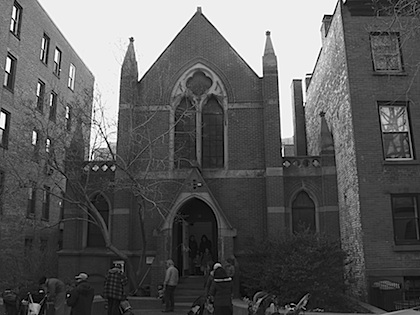During the Victorian era many wealthy people felt a religious obligation to aid the poor through privately organized uplift projects. Alfred Tredway White (1846-1921), a cousin of Seth Low the Younger, was the Heights’ greatest philanthropist and community activist. In 1880 he moved out of his father Alexander’s house at 2 Pierrepont Place into 40 Remsen Street.
In 1889 he built Riverside, model housing for the working class at Columbia Place (the continuation of Columbia Street) and Joralemon Street on the site of the Livingston-Pierrepont distillery. His motto on good works was “philanthropy plus five (or eight) percent”, indicating he thought one could make a profit helping the poor.
It originally housed 280 families in nine buildings surrounding a courtyard on the plan of his Tower and Home Buildings in Cobble Hill and is considered the first public housing in the U.S. In his classic book How the Other Half Lives, Jacob Riis called Riverside “the beau ideal of the model tenement.” Each apartment was well-lit ventilated, had its own toilet and recessed balcony—which was unusual for tenements of the period. Bathing, however, was communal and in the basement. The western four buildings were demolished for the Brooklyn-Queens Expressway in 1943 and underground parking was recently added. White included a bandstand in the courtyard where Saturday concerts were held. The reduced courtyard is now a shallow backyard. Since the 1980s successive owners have unsuccessfully sought to convert it into luxury housing.
The First Unitarian Church on Pierrepont Street constructed a Gothic Revival chapel in 1876 at 26 Willow Place to minister to the local workers in a then-industrial area. White began a kindergarten and community center there for the children of the Riverside Houses. As the neighborhood de-industrialized it was used first as a public school between 1928 and 1942. It also was reportedly a brothel during World War II, and was used as a furniture factory from 1947 until 1956. In the 1950s it was used as a mental health center. It is now the A.T. White Community Center, whose principal tenant is the Heights Players.
White founded, along with his cousin, Seth Low (the house next door to the A.A. Low House is the Alexander White House, Alfred Tredway’s father), the Brooklyn Bureau of Charities, whose building survives on Schermerhorn Street on the Downtown Brooklyn side of Court Street. He was Commissioner of City (Public) Works, and like his cousin Seth, was a Trustee of Tuskegee Institute, Hampton Institute, of the Regional Plan Association, and was involved in planning the model community of Forest Hills Gardens. He was also a founder of the Brooklyn Botanic Garden, and much of the land that became Marine Park near the eponymous bridge to the Rockaway peninsula. He also founded the Brooklyn Heights Association.
In 1921, White died tragically when he fell through the ice of a pond while ice-skating.
Robert Furman is working on a history of Brooklyn Heights called “Brooklyn Heights: The Rise, Fall and Rise of America’s First Suburb,” to be published later this year.




